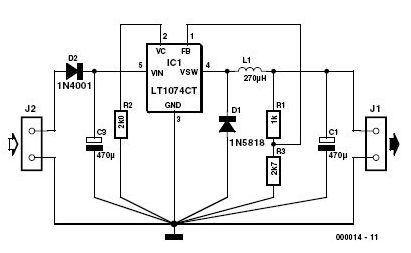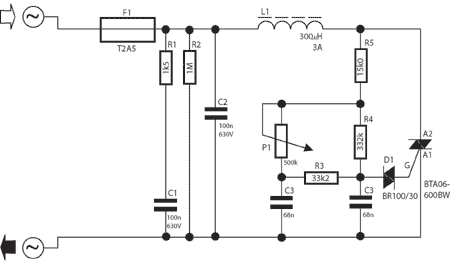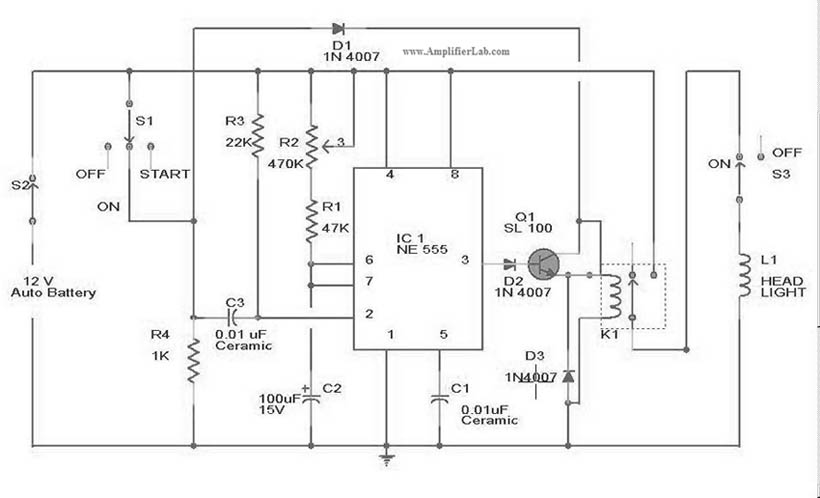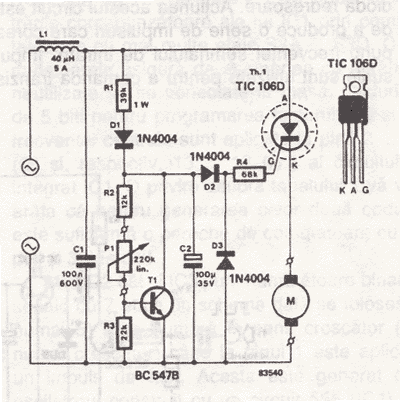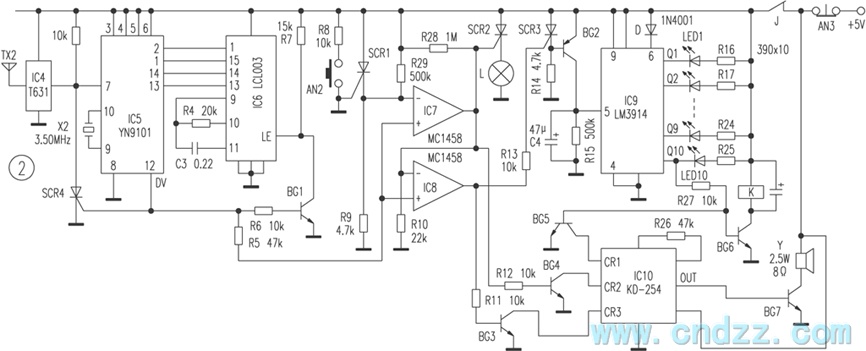
LA5522 Application Circuit
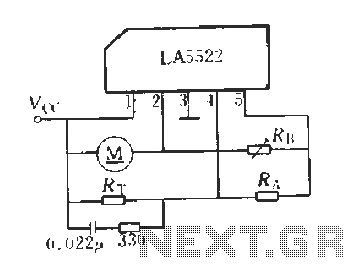
LA5522 Application Circuit. It operates as follows: When the supply voltage (Vcc) changes due to mechanical loads or negative changes, the motor speed may vary. The speed is proportional to the anti-electric potential (E), which also causes changes in the voltage across the motor. An adjustable resistor (R1, R4) samples the voltage (V) reflecting these changes and delivers it to the inverting input terminal of the error amplifier. This voltage is compared with the reference voltage (VREF) at the inverting input. The error amplifier adjusts the output voltage at pin 3 by controlling the base of two transistors. The output voltage at pin 3 and the feedback control exhibit a negative relationship, resulting in closed-loop control that maintains a constant speed.
The LA5522 application circuit is designed for motor speed control, utilizing a feedback mechanism to stabilize the motor's operation under varying load conditions. The circuit is configured to monitor the supply voltage (Vcc), which is critical for the motor's performance. When external factors cause a fluctuation in Vcc, the circuit compensates by adjusting the motor speed accordingly.
The adjustable resistors (R1 and R4) serve as voltage dividers that sample the operational voltage across the motor. This sampled voltage is crucial as it reflects the actual performance of the motor in real-time. The error amplifier plays a pivotal role in this circuit by comparing the sampled voltage with a predetermined reference voltage (VREF). This comparison allows the error amplifier to identify any discrepancies between the desired motor speed and the actual speed.
The output of the error amplifier is linked to the bases of two transistors, which act as a control mechanism for adjusting the motor's power supply. By modulating the base current of these transistors, the output voltage at pin 3 is finely tuned to ensure that the motor operates at the desired speed.
The feedback control system is designed to maintain a negative relationship between the output voltage and the feedback signal. This characteristic is essential for achieving a closed-loop control system that can adapt to changes in load or supply voltage, thereby ensuring that the motor speed remains constant despite external variations.
In summary, the LA5522 application circuit effectively combines voltage sampling, error amplification, and transistor control to provide a reliable motor speed regulation system. This design is particularly useful in applications where precise speed control is necessary, ensuring optimal performance and efficiency of the motor under varying operational conditions.LA5522 Application Circuit It works briefly as follows: When the supply voltage vcc motor mechanical or negative change when the load changes, can cause changes in motor speed. And speed proportional to the anti-electric potential E. Marrow also change accordingly the voltage across the motor also changes. From adjustable resistor 1, 4 on two sampled voltage v ,. Reflects these voltage changes, delivered to the error amplifier inverting input terminal, compare it with the inverting input of the reference voltage VREF, the error amplifier controls the two rear base of the transistor, the output voltage (pin 3) is adjusted. 3-pin output voltage and V. . There was a negative relationship between the feedback control, the results tend to be closed-loop control to maintain a constant speed.
The LA5522 application circuit is designed for motor speed control, utilizing a feedback mechanism to stabilize the motor's operation under varying load conditions. The circuit is configured to monitor the supply voltage (Vcc), which is critical for the motor's performance. When external factors cause a fluctuation in Vcc, the circuit compensates by adjusting the motor speed accordingly.
The adjustable resistors (R1 and R4) serve as voltage dividers that sample the operational voltage across the motor. This sampled voltage is crucial as it reflects the actual performance of the motor in real-time. The error amplifier plays a pivotal role in this circuit by comparing the sampled voltage with a predetermined reference voltage (VREF). This comparison allows the error amplifier to identify any discrepancies between the desired motor speed and the actual speed.
The output of the error amplifier is linked to the bases of two transistors, which act as a control mechanism for adjusting the motor's power supply. By modulating the base current of these transistors, the output voltage at pin 3 is finely tuned to ensure that the motor operates at the desired speed.
The feedback control system is designed to maintain a negative relationship between the output voltage and the feedback signal. This characteristic is essential for achieving a closed-loop control system that can adapt to changes in load or supply voltage, thereby ensuring that the motor speed remains constant despite external variations.
In summary, the LA5522 application circuit effectively combines voltage sampling, error amplification, and transistor control to provide a reliable motor speed regulation system. This design is particularly useful in applications where precise speed control is necessary, ensuring optimal performance and efficiency of the motor under varying operational conditions.LA5522 Application Circuit It works briefly as follows: When the supply voltage vcc motor mechanical or negative change when the load changes, can cause changes in motor speed. And speed proportional to the anti-electric potential E. Marrow also change accordingly the voltage across the motor also changes. From adjustable resistor 1, 4 on two sampled voltage v ,. Reflects these voltage changes, delivered to the error amplifier inverting input terminal, compare it with the inverting input of the reference voltage VREF, the error amplifier controls the two rear base of the transistor, the output voltage (pin 3) is adjusted. 3-pin output voltage and V. . There was a negative relationship between the feedback control, the results tend to be closed-loop control to maintain a constant speed.
